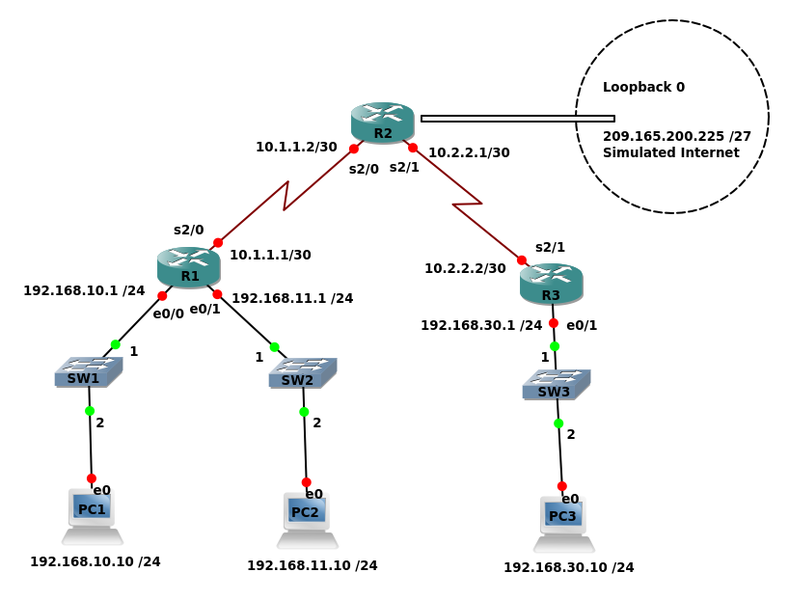Difference between revisions of "EVE ACL Challenge"
| Line 5: | Line 5: | ||
* Depending on the errors made, many students will break OSPF communications and thus all communications fail. It's a good learning experience but only if they eventually figure out what has happened. Many students assume the lack of communications is because the ACL is blocking their packets. In reality the router has no route because OSPF is down. | * Depending on the errors made, many students will break OSPF communications and thus all communications fail. It's a good learning experience but only if they eventually figure out what has happened. Many students assume the lack of communications is because the ACL is blocking their packets. In reality the router has no route because OSPF is down. | ||
* Virtual PCs produce meaningful outputs but there should be some example output showing Telnet success, failure and route unavailable. | * Virtual PCs produce meaningful outputs but there should be some example output showing Telnet success, failure and route unavailable. | ||
| − | [[Media: | + | [[Media:EVE_Basic_ACLs.zip|Basic ACLs Starting Topology]] |
=Topology= | =Topology= | ||
Revision as of 15:27, 5 October 2020
Contents
EVE Starting Topology
Reflections from the unit coordinator...
- Depending on the errors made, many students will break OSPF communications and thus all communications fail. It's a good learning experience but only if they eventually figure out what has happened. Many students assume the lack of communications is because the ACL is blocking their packets. In reality the router has no route because OSPF is down.
- Virtual PCs produce meaningful outputs but there should be some example output showing Telnet success, failure and route unavailable.
Topology
Addressing Table
Device Interface IP Address Subnet Mask Default Gateway
e0/0 192.168.10.1 255.255.255.0
R1 e0/1 192.168.11.1 255.255.255.0
s2/0 10.1.1.1 255.255.255.252
s2/0 10.1.1.2 255.255.255.252
R2 s2/1 10.2.2.1 255.255.255.252
Lo0 209.165.200.225 255.255.255.224
e0/1 192.168.30.1 255.255.255.0
R3 s2/1 10.2.2.2 255.255.255.252
PC1 NIC 192.168.10.10 255.255.255.0 192.168.10.1
PC2 NIC 192.168.11.10 255.255.255.0 192.168.11.1
PC3 NIC 192.168.30.10 255.255.255.0 192.168.30.1
Learning Objectives
- With reference to the Basic ACL Lab design and configure your own rules.
Preparation
- Run the EVE Topology and copy & paste the following configurations into the appropriate router and PC.
- Load the PC IP configurations with:
PC1
ip 192.168.10.10/24 192.168.10.1
PC2
ip 192.168.11.10/24 192.168.11.1
PC3
ip 192.168.30.10/24 192.168.30.1
- Ensure that there is end-to-end connectivity with the ping command.
Initial Router Configurations
R1
hostname R1 interface Ethernet0/0 no shutdown ip address 192.168.10.1 255.255.255.0 ! interface Ethernet0/1 no shutdown ip address 192.168.11.1 255.255.255.0 ! interface Serial2/0 no shutdown ip address 10.1.1.1 255.255.255.252 serial restart-delay 0 ! router ospf 1 network 10.1.1.0 0.0.0.3 area 0 network 192.168.10.0 0.0.0.255 area 0 network 192.168.11.0 0.0.0.255 area 0 ! line con 0 logging synchronous line aux 0 line vty 0 4 password cisco login transport input telnet ! ! end
R2
hostname R2 ! interface Serial2/0 no shutdown ip address 10.1.1.2 255.255.255.252 serial restart-delay 0 ! interface Serial2/1 no shutdown ip address 10.2.2.1 255.255.255.252 serial restart-delay 0 ! interface Serial2/2 no shutdown ip address 209.165.200.226 255.255.255.224 serial restart-delay 0 ! router ospf 1 network 10.1.1.0 0.0.0.3 area 0 network 10.2.2.0 0.0.0.3 area 0 network 209.165.200.224 0.0.0.31 area 0 default-information originate ! ip route 0.0.0.0 0.0.0.0 209.165.200.225 ! ! line con 0 logging synchronous line aux 0 line vty 0 4 password cisco login transport input telnet ! ! end
R3
hostname R3 ! interface Ethernet0/1 no shutdown ip address 192.168.30.1 255.255.255.0 ! interface Serial2/1 no shutdown ip address 10.2.2.2 255.255.255.252 serial restart-delay 0 ! router ospf 1 network 10.2.2.0 0.0.0.3 area 0 network 192.168.30.0 0.0.0.255 area 0 ! line con 0 logging synchronous line aux 0 line vty 0 4 password cisco login transport input telnet ! ! end
ISP
hostname Router ! interface Serial1/0 no shutdown ip address 209.165.200.225 255.255.255.224 serial restart-delay 0 ! no ip http server no ip http secure-server ip route 0.0.0.0 0.0.0.0 209.165.200.226 ! line con 0 logging synchronous line aux 0 line vty 0 4 login transport input none ! end
Security Policies
Note: * * * Don't apply ACLs to the Loopback - They are special interfaces and IN/OUT are meaningless * * *
Policy 1
No users on the 192.168.10.0 /24 network may send packets to the R2 address 10.1.1.2
- Design an appropriate ACL, apply and test it.
- Consider:
- Standard or Extended ACL?
- Where is it best applied.
There may be multiple answers depending on your assumptions. Discuss the options and your thoughts with your peers or the tutor.
Policy 2
Only users on the 192.168.11.0 /24 network may Telnet to 209.165.200.225
- Design an appropriate ACL, apply and test it.
- Consider:
- Standard or Extended ACL?
- Where is it best applied.
- This can be achieved with "access-groups" and "access-classes". Use either method but understand both.
- Careful to distinguish between IP and TCP.
There may be multiple answers depending on your assumptions. Discuss the options and your thoughts with your peers or the tutor.
Note that in EVE the Virtual PCs support a "ping" command that can be used to test TCP and UDP ports. To see the options try:
PC2> ping help
To test Telnet (port 23) connectivity to 209.165.200.225:
PC2> ping 209.165.200.225 -3 -p 23
Policy 3
Users on IP addresses between 192.168.30.32 and 192.168.30.40 may not ping the Internet Loopback address
- Design an appropriate ACL, apply and test it.
- Consider:
- Standard or Extended ACL?
- Where is it best applied.
- Remember the "implicit deny"
There may be multiple answers depending on your assumptions. Discuss the options and your thoughts with your peers or the tutor.
